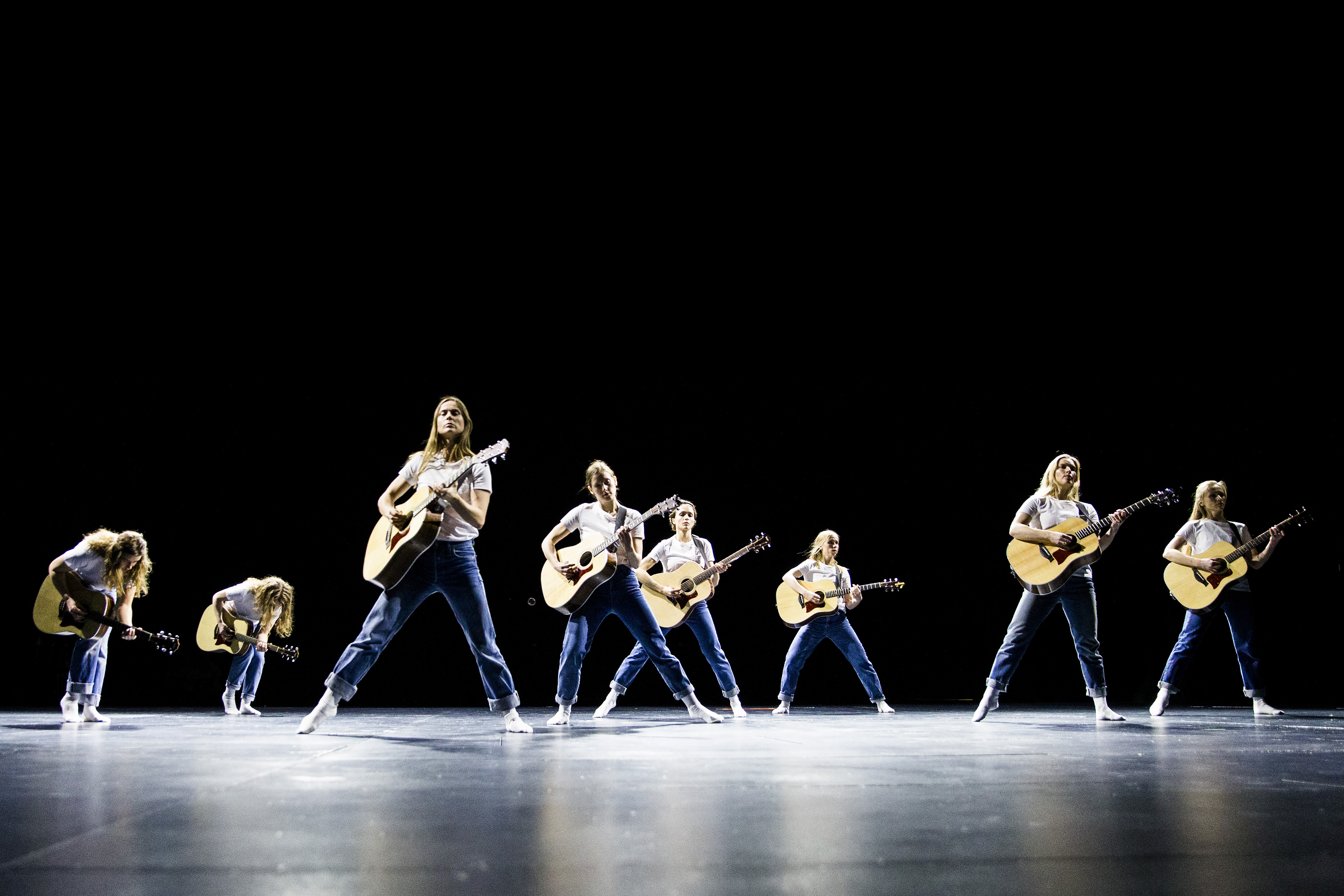Experimental ballet. No Tomorrow
No Tomorrow is a conceptual take on ballet for six dancers and six guitars, staged by Ragnar Kjartansson and choreographer Margrét Bjarnadóttir with music by Bryce Dessner. Its simplicity and effectiveness make it a reflection on the grace, inner strength and skills of the dancer.
* The performance is cancelled due to the decision of its participants.
For almost half an hour six dancers clad in the normcore uniform of identical jeans and white T-shirts perform a choreographic composition, accompanying themselves on guitars. No Tomorrow is no less a sonic musical experiment then a dance piece.
The title comes from the French novella Point de Lendemain (“No Tomorrow”) by Dominique Vivant-Denon. Written in the late 18th century, Point de Lendemain is a masterpiece of secular literature of the time.
The verbal landscapes of the story are reminiscent of canvases by the master of “gallant scenes”, Jean-Antoine Watteau. Frozen in graceful poses, often in dance, Watteau’s characters are wistful, lacking in individual features and almost ephemeral in appearance, and the actions of his paintings suggest no development.

No Tomorrow is an opus to abstract beauty and unnamed emotions, transparent and resonant minimalism, a ghost ballet. Dressed in casual clothes, the dancers move so gracefully that the endless repetitions of steps and the weaving of choreographic drawings become an unobtrusive mantra, an invitation to deep meditation. The singing of the dancers has a mesmerizing effect, like voices of sirens, imperceptibly transporting the entire audience to an island of peace and ghostly romanticism. No Tomorrow is a manifesto of rhythm, movement and chords, vaguely remembered emotions. A reflection on the beauty and elegance, inner strength and art of a dancer.
Kjartansson and Bjarnadóttir describe No Tomorrow as a homage to Watteau. Indeed, despite the lack of decoration and the emphatically simple costumes, the performance is deeply indebted to the Rococo style, of which Kjartansson is a declared devotee. The remote melancholy of their sung refrain and the repetitive pattern of their steps make No Tomorrow into an almost meditative experience. The music was written by Bryce Dessner, a composer and guitarist of the rock band The National, with whom Kjartansson also collaborated for the six-hour performance A Lot of Sorrow which is part of the exhibition To Moscow! To Moscow! To Moscow!
Bryce has scored music for contemporary dance throughout his career and wrote No Tomorrow's music with the idea of complicated counting patterns that only dancers could actualize. This is not music for guitarist, it’s music for dancers. Many of the performers of No Tomorrow did not know how to play the guitar before entering this project. They learnt the chords, picks and strums together with the choreography. The music of the ballet is in keeping with its movement — fragile, vulnerable and barely audible when the dancers retreat to the back of the stage or turn their backs to the audience. The bulky guitar, inseparable from each dancer throughout the performance, at times seems to be an extension of their body. No Tomorrow, like Vivant-Denon’s story, offers no final moral. Endless repetition turns into a manifesto of rhythm, movement and live sound.
On March 5, following the screening, a talk with the authors will be held: Margret Bjarnadottir and Ragnar Kjartansson will tell about their work on the dance performance. We invite everyone to participate.
The ballet was premiered at the Sacrifice Festival in Reykjavik in 2017.
Performers
Aðalheiður Halldórsdóttir, Anais Florence Lea Barthe, Elín Signý Weywadt Ragnarsdóttir, Halla Þórðardóttir, Inga Maren Rúnarsdóttir and Lovísa Ósk Gunnarsdóttir
Commissioned by The Icelandic Dance Company
Curator Olga Tsvetkova
Ragnar Kjartansson is an artist and musician. Born in 1976 in Reykjavik, he studied at the Icelandic Academy of Arts and the Royal Academy in Stockholm. Kjartansson’s solo exhibitions and performances have been held in many leading museums around the world. In 2009, Kjartansson represented Iceland at the Venice Biennale, and in 2013 his works were shown at the main exhibition of the Biennale, Encyclopedic Palace. He uses various artistic techniques and mediums. Kjartansson’s works are associated with emotionality and humor, each of them influenced by the comedies and tragedies of classical theatre.
Margret Bjarnadottir is an Icelandic artist and choreographer who works at the intersection of dance, performance, visual arts and literature. Her diverse practice includes choreography, photography and video, texts, playing drum kits and creating glass objects. Margret was the choreographer of Bjork’s concert tour Utopia (2017) and her Cornucopia show in 2019.
Bryce Dessner is the composer and guitarist of the band The National, and is also actively engaged in curatorial activities. He has composed orchestral, chamber and vocal compositions for the Los Angeles Philharmonic Orchestra, the Metropolitan Museum of Art and the New York Philharmonic Orchestra, the Kronos Quartet, the Barbican Art Centre, and the New York City Ballet Company. His works have been performed at the most celebrated music festivals.
Attention! A smoke generator (fog machine) is used during the performance. If you are prone to allergic reactions or have lung or upper respiratory tract diseases, as well as other possible risk factors, please assess potential risks to your health in advance and/or consult a doctor.